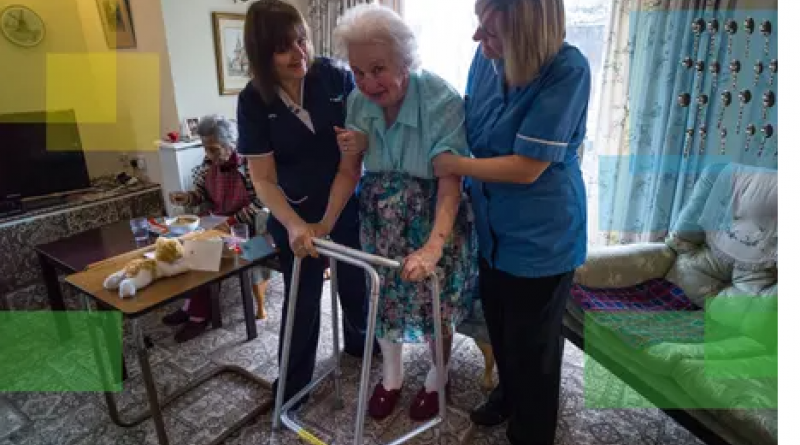Transforming care must be central to any bold vision of a greener future

Care work – paid and unpaid – has huge knock-on effects for the climate that can no longer be ignored
It is no coincidence that both care and our climate are in crisis. Addressing each requires us to recognise that we are vulnerable and interdependent, as a species and individually. This will only become more apparent, because – as the world gets hotter and consequently more dangerous – we are going to need to care for each other more than ever before. As initiatives including Naomi Klein’s The Leap and the Feminist Green New Deal have explained, we need a care-centred approach to meet the demands of a future that looks very different to our past.
First, we must broaden our understanding of what constitutes a “green job”. Research by the Feminist Green New Deal has found that a majority of people identify solar panel installers as green workers, but far fewer consider care workers to be in the same camp. This shows us something important about our mindset. So far, we have thought in terms of greening highly polluting industries – turning from fossil fuels to renewables – rather than identifying what is simply green, ie what is low-carbon by nature. This is the difference between tweaking our current system and stepping into a new approach that makes different kinds of work central to our economy. From this perspective, care work becomes a core component of our future, as those calling for its inclusion in a green new deal have advocated.
Centring care in industrial visions is a bold and expansive new way of thinking about our future, but we must be wary of making a category error. Care isn’t solely a sector or a job; it’s also what political scientist Prof Joan Tronto has termed a “species activity”.
Most care for the sick, impaired or elderly in the world today is performed unpaid and informally, by family and friends. When we think in terms of care as an economic sector, we risk overlooking what this means from a climate perspective. The carbon intensity of care, as a species activity, is contingent on the general structures and patterns of our lives. It is a bigger question, then, than a green jobs strategy can house. For example, many caregivers make frequent petrol-guzzling journeys to support their elderly parents. This raises obvious questions about transport, but we also need to consider housing.
The Older Women’s Co-Housing project in north London provides a pioneering model, based on wider co-housing movements in northern Europe. Its hybrid approach of private, accessible dwellings with shared community spaces enables older women to care for themselves and each other more effectively than if they lived as isolated individuals. This reduces the need for journeys by family members living separately.
Alternatively, I’ve learnt through my interviews with caregivers that many would value modular homes to enable elderly parents or impaired adult children to live with them without loss of privacy and personal space. Either of these housing alternatives would reduce caregivers’ well-documented strain by limiting the financial and energetic impact of caring, while also reducing carbon footprints.
Consider, also, that 14% of the UK workforce juggle caring responsibilities (not including standard parenting) with paid work. Academics have found that the resultant “time squeeze” (otherwise known as sheer exhaustion) can affect the carbon intensity of lifestyle choices, such as opting for ready meals or food deliveries, driving instead of taking lengthier or less predictable public transport, and using more time-saving electrical devices. This can’t be solved without introducing new employment rights for caregivers, including the right to work flexibly and sufficient paid carer’s leave.
Care – the arduous, bodily practice, which it is sometimes forgotten to be – is also a minefield of disposability and devices. The use of medical equipment in the home has increased and many products considered vital for both hygiene and dignity are non-reusable. The adult incontinence product market is just one example. In 2020, its global market value reached $15.4 bn (£11.2bn) and is projected to hit $24.2bn by 2026. This is because incontinence, uncomfortable as this fact may be, is a common side effect of ageing and specific health issues, such as dementia, Parkinson’s and cancer treatment. Work currently under way to make the NHS net zero could be transferred to caring, including attempts to reduce waste.
If care is considered not just as a sector but also a practice of life, terrifying intersections between it and the global climate crisis appear that also need serious attention. When we think about climate-provoked migration, we rarely ask who gets to migrate. It’s not the unpaid caregivers. Anil Patil is the founder and executive director of Carers Worldwide, a charity that supports carers in Nepal, India and Bangladesh. “We have to raise awareness of the specific risks of climate change to carers,” he told me. In each of these south Asian countries, Carers Worldwide and its partners are seeing climate change directly harming carers’ ability to meet basic needs.
Wells drying up or domestic water supplies being diverted to parched farmland mean that lengthy journeys to collect water are created – journeys that just aren’t feasible for those supporting someone with high dependencies.
Many carers are unable to leave the person whom they support unattended for more than a few minutes at most, depending on the specific illness or impairment. Yet in Nepal, when increasingly frequent landslides occur, accessing relief trucks often requires a two- to three-hour walk. “In most disaster and mitigation plans, carers are forgotten,” Patil explains. “They can’t access relief, and if there are no organisations advocating for them, they have no voice.” This isn’t unique to the global south: care worker Theresa Santos died in 2017 in a northern California wildfire when she stayed with her immobile client rather than save herself. We must be wary of assuming all people are equally mobile when considering the dangers of the climate crisis.
Santos stands out because she acted selflessly. After all, she was paid to be there; others may have abandoned their client to save themselves. But for unpaid caregivers supporting a loved one, they will feel little option but to remain in danger. And it’s those people – mostly women – whom we must centre in climate and care narratives. They and those for whom they care are the ultimate example of those two inescapable facts about our species: we are both vulnerable and interdependent. The challenge for our future lies in whether we have the courage to recognise these facts and create a vision that puts them at its heart.
-
Emily Kenway is a writer and author of The Truth About Modern Slavery
25 October 2021
The Guardian




